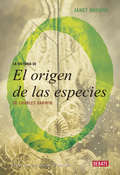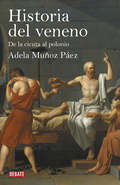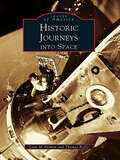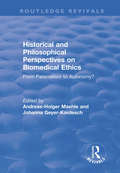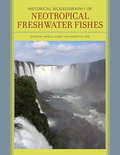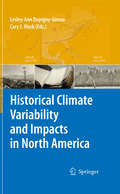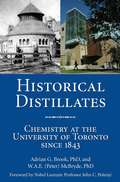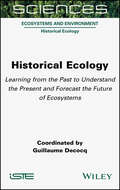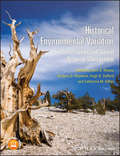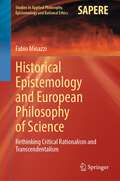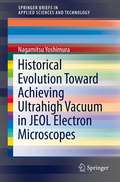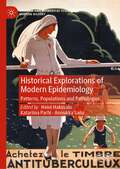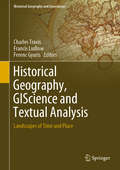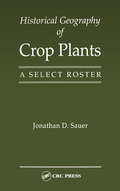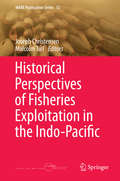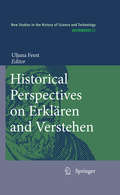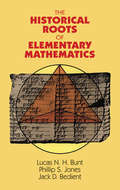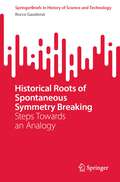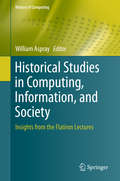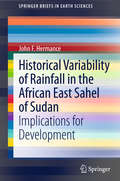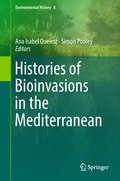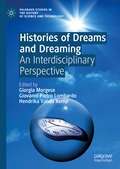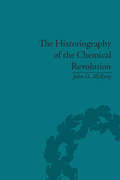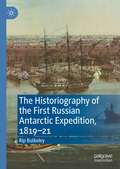- Table View
- List View
La historia de El origen de las especies
by Janet BrowneJanet Browne, la estudiosa más importante de Darwin, explica por qué El origen de las especies puede ser considerado justamente el libro científico más importante jamás publicado Ningún libro ha cambiado tanto nuestra concepción de nosotros mismos como El origen de las especies, de Charles Darwin. Provocó un escándalo el mismo día de su publicación y se convirtió en un bestseller mundial. La idea de que los seres vivos evolucionan gradualmente debido a la selección natural conmocionó profundamente a sus lectores victorianos y cuestionó la fe inquebrantable de muchos en la existencia de un creador. En este libro, Janet Browne, la estudiosa más importante de Darwin, explica por qué El origen de las especies puede ser considerado justamente el libro científico más importante jamás publicado. Para ello, describe la génesis de las teorías de Darwin, explica cómo fueron recibidas inicialmente y se pregunta porqué siguen siendo tan polémicas hoy día.
Historia del veneno: De la cicuta al polonio
by Adela Muñoz PáezCicuta, arsénico, cianuro, talio, polonio... Adela Muñoz realiza un insólito recorrido por los momentos más relevantes de la historia a partir de envenenamientos célebres La fascinación del ser humano por los venenos se remonta al principio de los tiempos. Ya en el antiguo Egipto y en el mundo grecorromano, los tósigos se convirtieron en un arma de poder. En Roma fueron muchos los emperadores que alcanzaron la gloria gracias a ellos: Nerón mató a su madre, Agripina la Menor, quien a su vez había asesina - do al emperador Claudio para conseguir la corona de su hijo. También en la Italia renacentista, y en la Francia de Luis XIV, las pócimas causaron estragos, y reyes, cortesanos y plebeyos perdieron la vida bajo sus efectos. Adela Muñoz nos descubre la composición de los venenos que acabaron con la vida de personajes ilustres como Sócrates, Cleopatra, el emperador Claudio, Rasputín o Adolf Hitler. Una fascinante historia desde la cicuta de la Antigüedad al polonio de nuestros días.
Historic Journeys Into Space (Images of America)
by Lynn M. Homan Thomas ReillyFrom the January 1958 launch of the first American satellite to the creation of the National Aeronautics and Space Administration by President Eisenhower just a few months later, from the heated space race of the Cold War era to the heroes of shuttle launches, the United States has been on the leading edge of space exploration and technology. Initially developed from one of Adolph Hitler's most feared weapons, the V2 rocket, the space program has accomplished much in just a few short decades. The first American manned space flight, which put astronaut Alan Shepard into space, was launched in 1961; in 1965, Edward White became the first American to walk in space--for a total of 21 minutes. In 1969, Neil Armstrong uttered those now-famous words as he became the first human to walk on the Moon. These and many other achievements, once considered unimaginable, have inspired and amazed the American people and engaged our brightest scientific minds.
Historical and Philosophical Perspectives on Biomedical Ethics: From Paternalism to Autonomy? (Routledge Revivals)
by Andreas-Holger Maehle Johanna Geyer-KordeschThis title was first published in 2002: This volume discusses the subject of biomedical ethics. Various views, historical and contemporary, are discussed, with the editors using the contrasting concepts in the shift from paternalism to autonomy in 20th-century medicine as a heuristic tool for the critical study of ethics in medicine.As far as the evidence in this volume goes, paternalistic medical practices and patient autonomy had an uneasy relationship by the beginning of the 20th century. A hundred years later, full autonomy in decisions on medical treatment is still subject to numerous caveats. The text pays close attention to the interplay between various players, noting how factors such as social contexts, governmental organizations and the biotechnological industry influence and shape responses to the principle of bioethics.
Historical Biogeography of Neotropical Freshwater Fishes
by James S. Albert Roberto E. ReisThe fish faunas of continental South and Central America constitute one of the greatest concentrations of aquatic diversity on Earth, consisting of about 10 percent of all living vertebrate species. Historical Biogeography of Neotropical Freshwater Fishes explores the evolutionary origins of this unique ecosystem. The chapters address central themes in the study of tropical biodiversity: why is the Amazon basin home to so many distinct evolutionary lineages? What roles do ecological specialization, speciation, and extinction play in the formation of regional assemblages? How do dispersal barriers contribute to isolation and diversification? Focusing on whole faunas rather than individual taxonomic groups, this volume shows that the area's high regional diversity is not the result of recent diversification in lowland tropical rainforests. Rather, it is the product of species accumulating over tens of millions of years and across a continental arena.
Historical Climate Variability and Impacts in North America
by Cary J. Mock Lesley-Ann Dupigny-GirouxClimatologists with an eye on the past have any number of sources for their work, from personal diaries to weather station reports. Piecing together the trajectory of a weather event can thus be a painstaking process taking years and involving real detective work. Missing pieces of a climate puzzle can come from very far afield, often in unlikely places. In this book, a series of case studies examine specific regions across North America, using instrumental and documentary data from the 17th to the 19th centuries. Extreme weather events such as the Sitka hurricane of 1880 are recounted in detail, while the chapters also cover more widespread phenomena such as the collapse of the Low Country rice culture. The book also looks at the role of weather station histories in complementing the instrumental record, and sets out the methods that involve early instrumental and documentary climate data. Finally, the book's focus on North America reflects the fact that the historical climate community there has only grown relatively recently. Up to now, most such studies have focused on Europe and Asia. The four sections begin with regional case studies, and move on to reconstruct extreme events and parameters. This is followed by the role of station history and, lastly, methodologies and other analyses. The editors' aim has been to produce a volume that would be instrumental in molding the next generation of historical climatologists. They designed this book for use by general researchers as well as in upper-level undergraduate or graduate level courses.
Historical Distillates: Chemistry at the University of Toronto Since 1843
by Adrian G. Brook W. A. E. Peter McBrydeHistorical Distillates examines the history of the Chemistry Department at the University of Toronto from its beginnings in 1843, when it was housed in simple quarters in the Parliament Buildings on Front Street and had just one faculty member. During the founding era (1843-1920) three British gentlemen professors guided the department through four homes; between 1920 and 1960 three Canadian heads built a highly influential department. Since 1960 eight chairmen have effectively managed a growing and diverse department while it ventured into exciting new fields and emerging sub-disciplines. New colleges and a Nobel Prize have been highlights of the past two decades. With the completion of recent renovations and additions (such as the Davenport Research Building and Garden), with its distinguished faculty, top-rate staff, and excellent students, and with its dazzling array of equipment to support research, the department’s future indeed looks bright.
Historical Ecology: Learning from the Past to Understand the Present and Forecast the Future of Ecosystems
by Guillaume DecocqThis book addresses present-day landscapes, ecosystem functioning and biodiversity as legacies of the past. It implements an interdisciplinary approach to understand how natural or human-impacted ecological systems have changed over time.Historical Ecology combines theory, methods, regional case studies and syntheses to provide a complete up-to-date overview of historical ecology. Beginning with the crucial role of time and inference from observed patterns, the book critically reviews the main methodological approaches, including monitoring of permanent plots, analysis of old maps, repeat photography, remote sensing, soil analysis, charcoal analysis, botanical indicators, and combinations of these methods applied to forest ecosystems.A series of case studies from various biomes shows how historical ecology can help in understanding today&’s socio-ecosystems, such as mainland and island forests, orchards, tundra and coastal dunes. The book concludes by showing how historical ecology can answer timely fundamental research questions and provide science-based evidence for landscape and ecosystem management.
Historical Environmental Variation in Conservation and Natural Resource Management
by John A. Wiens Gregory D. Hayward Hugh D, Safford Catherine GiffenIn North America, concepts of Historical Range of Variability are being employed in land-management planning for properties of private organizations and multiple government agencies. The National Park Service, U.S. Fish & Wildlife Service, Bureau of Land Management, U.S. Forest Service, and The Nature Conservancy all include elements of historical ecology in their planning processes. Similar approaches are part of land management and conservation in Europe and Australia. Each of these user groups must struggle with the added complication of rapid climate change, rapid land-use change, and technical issues in order to employ historical ecology effectively. Historical Environmental Variation in Conservation and Natural Resource Management explores the utility of historical ecology in a management and conservation context and the development of concepts related to understanding future ranges of variability. It provides guidance and insights to all those entrusted with managing and conserving natural resources: land-use planners, ecologists, fire scientists, natural resource policy makers, conservation biologists, refuge and preserve managers, and field practitioners. The book will be particularly timely as science-based management is once again emphasized in United States federal land management and as an understanding of the potential effects of climate change becomes more widespread among resource managers.Additional resources for this book can be found at: www.wiley.com/go/wiens/historicalenvironmentalvariation.
Historical Epistemology and European Philosophy of Science: Rethinking Critical Rationalism and Transcendentalism (Studies in Applied Philosophy, Epistemology and Rational Ethics #62)
by Fabio MinazziThis book offers a comprehensive analysis on the evolution of philosophy of science, with a special emphasis on the European tradition of the twentieth century. At first, it shows how the epistemological problem of the objectivity of knowledge and axiomatic knowledge have been previously tackled by transcendentalism, critical rationalism and hermeneutics. In turn, it analyses the axiological dimension of scientific research, moving from traditional model of science and of scientific methods, to the construction of a new image of knowledge that leverages the philosophical tradition of the Milan School. Using this historical-epistemological approach, the author rethinks the Kantian Transcendental, showing how it could be better integrated in the current philosophy of science, to answer important questions such as the relationship between science and history, scientific and social perspectives and philosophy and technology, among others. Not only this book provides a comprehensive study of the evolution of European Philosophy of Science in the twentieth century, yet it offers a new, historical and epistemological-based approach, that could be used to answers many urgent questions of contemporary societies.
Historical Evolution Toward Achieving Ultrahigh Vacuum in JEOL Electron Microscopes
by Nagamitsu YoshimuraThis book describes the developmental history of the vacuum system of the transmission electron microscope (TEM) at the Japan Electron Optics Laboratory (JEOL) from its inception to its use in today's high-technology microscopes. The author and his colleagues were engaged in developing vacuum technology for electron microscopes (JEM series) at JEOL for many years. This volume presents a summary and explanation of their work and the technology that makes possible a clean ultrahigh vacuum. The typical users of the TEM are top-level researchers working at the frontiers of new materials or with new biological specimens. They often use the TEM under extremely severe conditions, with problems sometimes occurring in the vacuum system of the microscopes. JEOL engineers then must work as quickly as possible to improve the vacuum evacuation system so as to prevent the recurrence of such problems. Among the wealth of explanatory material in this book are examples of users' reports of problems in the vacuum system of the JEM, such as the occurrence of a micro-discharge and the back-streaming of the diffusion pump (DP) oil vapor. This work is a valuable resource for researchers who use the transmission electron microscope and for engineers and scientists interested in its technology.
Historical Explorations of Modern Epidemiology: Patterns, Populations and Pathologies (Medicine and Biomedical Sciences in Modern History)
by Heini Hakosalo Katariina Parhi Annukka SailoThis volume explores the history of epidemiology from the mid-twentieth century to the present. Epidemiology has exerted major influence on the way that both infectious and chronic diseases are conceptualized and controlled, and, more generally, on the way that people in modern societies think about health, behavior, longevity, and risk. This collection consists of a series of in-depth analyses of the roots, development, and impact of epidemiological research, illuminating the complex relationship between medical research and data on the one hand, and social and cultural factors on the other. The thematical and geographical scope of the book ranges from indigenous and participant perspectives to the visualization of pandemics, and from Circumpolar North to East Africa. The book identifies significant historical changes and the driving forces behind them, charting forms of science-society interaction that characterize modern epidemiology. Chapter 1 and chapter 4 are available open access under a Creative Commons Attribution 4.0 International License via link.springer.com.
Historical Geography, GIScience and Textual Analysis: Landscapes of Time and Place (Historical Geography and Geosciences)
by Charles Travis Francis Ludlow Ferenc GyurisThis book illustrates how literature, history and geographical analysis complement and enrich each other’s disciplinary endeavors. The Hun-Lenox Globe, constructed in 1510, contains the Latin phrase 'Hic sunt dracones' ('Here be dragons'), warning sailors of the dangers of drifting into uncharted waters. Nearly half a millennium earlier, the practice of ‘earth-writing’ (geographia) emerged from the cloisters of the great library of Alexandria, as a discipline blending the twin pursuits of Strabo’s poetic impression of places, and Herodotus’ chronicles of events and cultures. Eratosthenes, a librarian at Alexandria, and the mathematician Ptolemy employed geometry as another language with which to pursue ‘earth-writing’. From this ancient, East Mediterranean fount, the streams of literary perception, historical record and geographical analysis (phenomenological and Euclidean) found confluence. The aim of this collection is to recover such means and seek the fount of such rich waters, by exploring relations between historical geography, geographic information science (GIS) / geoscience, and textual analysis. The book discusses and illustrates current case studies, trends and discourses in European, American and Asian spheres, where historical geography is practiced in concert with human and physical applications of GIS (and the broader geosciences) and the analysis of text - broadly conceived as archival, literary, historical, cultural, climatic, scientific, digital, cinematic and media. Time as a multi-scaled concept (again, broadly conceived) is the pivot around which the interdisciplinary contributions to this volume revolve. In The Landscape of Time (2002) the historian John Lewis Gaddis posits: “What if we were to think of history as a kind of mapping?” He links the ancient practice of mapmaking with the three-part conception of time (past, present, and future). Gaddis presents the practices of cartography and historical narrative as attempts to manage infinitely complex subjects by imposing abstract grids to frame the phenomena being examined— longitude and latitude to frame landscapes and, occidental and oriental temporal scales to frame timescapes. Gaddis contends that if the past is a landscape and history is the way we represent it, then it follows that pattern recognition constitutes a primary form of human perception, one that can be parsed empirically, statistically and phenomenologically. In turn, this volume reasons that literary, historical, cartographical, scientific, mathematical, and counterfactual narratives create their own spatio-temporal frames of reference. Confluences between the poetic and the positivistic; the empirical and the impressionistic; the epic and the episodic; and the chronologic and the chorologic, can be identified and studied by integrating practices in historical geography, GIScience / geoscience and textual analysis. As a result, new perceptions and insights, facilitating further avenues of scholarship into uncharted waters emerge. The various ways in which geographical, historical and textual perspectives are hermeneutically woven together in this volume illuminates the different methods with which to explore terrae incognitaes of knowledge beyond the shores of their own separate disciplinary islands.
Historical Geography of Crop Plants: A Select Roster
by Jonathan D. SauerHistorical Geography of Crop Plants is devoted to a variety of staple and food crops, as well as fodder, fiber, timber, rubber, and other crops. The origins and histories of many of these crops have been clarified only recently by new research. The book has been arranged alphabetically by family and higher taxa for easy reference. Within families, species and cultivars are listed chronologically and geographically. The taxonomy and geography of probable wild progenitors have been outlined, and archeological evidence (when available) and historical evidence on region and domestication are traced. The subsequent evolution and spread of many domesticated species are examined, and the reasons behind the diversity in crop histories are explored. Historical Geography of Crop Plants will be a useful reference for botanists, economic botanists, ethnobiologists, agronomists, geographers, and others interested in the subject.
Historical Perspectives of Fisheries Exploitation in the Indo-Pacific
by Joseph Christensen Malcolm TullThe waters of the Indo-Pacific were at the centre of the global expansion of marine capture fisheries in the twentieth century, yet surprisingly little has been written about this subject from a historical perspective. This book, the first major study of the history of fishing in Asia and Oceania, presents the case-studies completed through the History of Marine Animal Populations (HMAP) initiative. It examines the marine environmental history and historical marine ecology of the Indo-Pacific during a period that witnessed the dramatic escalation of industrial fishing in these seas.
Historical Perspectives on Erklären and Verstehen
by Uljana FeestThe conceptual pair of "Erklären" and "Verstehen" (explanation and understanding) has been an object of philosophical and methodological debates for well over a century. Discussions - to this day - are centered around the question of whether certain objects or issues, such as those dealing with humans or society, require a special approach, different from that of the physical sciences. In the course of such philosophical discussions, we frequently find references to historical predecessors, such as Dilthey's discussion of the relationship between "Geisteswissenschaft" and "Naturwissenschaft", Windelband's distinction between nomothetic and idiographic methods, or Weber's conception of an interpretative sociology. However, these concepts are rarely placed in the historical contexts of their emergence. Nor have the shifting meanings of these terms been analyzed. The present volume considers a variety of intellectual, social, and material factors that contributed to the debate. Far from reducing the debates to their cultural and institutional contexts, however, the volume also offers careful systematic reconstructions of the arguments at hand, thereby enabling the reader to not only appreciate the situatedness of this exciting period of intellectual history, but also to reflect upon the current relevance of the various interpretations of the dichotomy between explanation and understanding.
The Historical Roots of Elementary Mathematics
by Lucas N. Bunt Jack D. Bedient Phillip S. Jones"Will delight a broad spectrum of readers." -- American Mathematical MonthlyDo long division as the ancient Egyptians did! Solve quadratic equations like the Babylonians! Study geometry just as students did in Euclid's day! This unique text offers students of mathematics an exciting and enjoyable approach to geometry and number systems. Written in a fresh and thoroughly diverting style, the text -- while designed chiefly for classroom use -- will appeal to anyone curious about mathematical inscriptions on Egyptian papyri, Babylonian cuneiform tablets, and other ancient records.The authors have produced an illuminated volume that traces the history of mathematics -- beginning with the Egyptians and ending with abstract foundations laid at the end of the 19th century. By focusing on the actual operations and processes outlined in the text, students become involved in the same problems and situations that once confronted the ancient pioneers of mathematics. The text encourages readers to carry out fundamental algebraic and geometric operations used by the Egyptians and Babylonians, to examine the roots of Greek mathematics and philosophy, and to tackle still-famous problems such as squaring the circle and various trisectorizations.Unique in its detailed discussion of these topics, this book is sure to be welcomed by a broad range of interested readers. The subject matter is suitable for prospective elementary and secondary school teachers, as enrichment material for high school students, and for enlightening the general reader. No specialized or advanced background beyond high school mathematics is required.
Historical Roots of Spontaneous Symmetry Breaking: Steps Towards an Analogy (SpringerBriefs in History of Science and Technology)
by Rocco GaudenziWhat are the thinking processes and knowledge resources involved in a complex discovery? How can the physics of solids, the physics of nuclei, and elementary particle physics cross-fertilise in spite of the widely differing domains and energy scales they deal with? This book addresses the questions by reconstructing and examining from the historical epistemological perspective the fascinating heuristic path to the concept of spontaneous symmetry breaking. This analysis especially brings to light the role that analogical reasoning and mathematical reformulations played in the discovery process, as well as the influence of the Japanese milieu and approach to physical problems.
Historical Studies in Computing, Information, and Society: Insights from the Flatiron Lectures (History of Computing)
by William AsprayThis is a volume of chapters on the historical study of information, computing, and society written by seven of the most senior, distinguished members of the History of Computing field. These are edited, expanded versions of papers presented in a distinguished lecture series in 2018 at the University of Colorado Boulder – in the shadow of the Flatirons, the front range of the Rocky Mountains. Topics range widely across the history of computing. They include the digitalization of computer and communication technologies, gender history of computing, the history of data science, incentives for innovation in the computing field, labor history of computing, and the process of standardization. Authors were given wide latitude to write on a topic of their own choice, so long as the result is an exemplary article that represents the highest level of scholarship in the field, producing articles that scholars in the field will still look to read twenty years from now. The intention is to publish articles of general interest, well situated in the research literature, well grounded in source material, and well-polished pieces of writing. The volume is primarily of interest to historians of computing, but individual articles will be of interest to scholars in media studies, communication, computer science, cognitive science, general and technology history, and business.
Historical Variability of Rainfall in the African East Sahel of Sudan: Implications for Development
by John F. HermanceThe northward migration of the African monsoon rains in summer, associated with the seasonal march of the Intertropical Convergence Zone (ITCZ) across the plains south of the Sahara, is the most critical asset for the livelihoods of indigenous peoples and local economies of the Sahel. It is essential that climate science (and its publicly available database) play a key role in characterizing the variabilities of these rainfall patterns in space and time if sustainable life styles are to accommodate the expanding populations of the region. This study turns to the East Sahel of Sudan by analyzing over 100 years of historical rainfall data from three of the few long term standard WMO rain gauge stations in substantially different rainfall settings. From north to south, transecting the Sahel, the stations with their annual rainfall are Khartoum (130 mm); Kassala (280 mm); and Gedaref (600 mm). The conclusions challenge a popular notion that changing climate, drought and desertification in the East Sahel may have already accelerated the deterioration of its water resources. However, any evidence of a persistent and coherent regional trend of diminishing rainfall is obscure. Quite the contrary, the evidence demonstrates that the fluctuations of climate and weather patterns over the ensuing decades of the past century - at all temporal scales from days to years to decades - profoundly overwhelm any suggestion of a large-scale, coherent decrease (or increase) in rainfall. The implication is that, it is not long term change, but the highly localized interseasonal, interannual and multiannual variability of rainfall that poses the greatest and most immediate societal threat from naturally-induced causes; a process constantly destabilizing an agrarian economy struggling to survive in a climate that irregularly vacillates between years of drought and years of flooding. While this report may have some interest for climate scientists, it is primarily directed to a general readership (including students in public policy and anthropology) concerned with the availability of water in the Sahel, particularly the long term sustainability of local small-scale farms and transhumant pastoralism.
Histories of Bioinvasions in the Mediterranean (Environmental History Ser. #8)
by Ana Isabel Queiroz Simon PooleyBioinvasions is a current top research subject for natural sciences, social sciences and humanities and a major concern for conservationists, land managers and planners. In the last decades, new findings, perspectives and practices have revealed the multifaceted challenges of preventing new introductions and dealing with those invasive species that harm natural ecosystems, economy and human welfare. This book brings together environmental historians and natural scientists to share their studies and experiences on the human dimensions of biological invasions from the ancient past to the current challenges. The collection of papers focuses on the Mediterranean region and deals with aquatic and terrestrial ecosystems on the mainland and islands, ranging from marine and freshwater environments to coastal marshlands and forests. A wide diversity of animals and plants are featured, from marine fishes to marine and freshwater crustaceans, invertebrates, reptiles and amphibians, birds and mammals, to grasses, shrubs and trees. This book is a contribution to the scientific debate on how to deal with the historical dimensions of biological invasions, fostering dialogue between cultural and ecological explanations of environmental change, to inform environmental policy and management. It has been organized in three sections: the first is the editors’ introduction, in which they review the existing literature and highlight relevant concepts and ideas; the second is about alien species in the Mediterranean region; the third includes cases from other Mediterranean-type regions.
Histories of Dreams and Dreaming: An Interdisciplinary Perspective (Palgrave Studies in the History of Science and Technology)
by Giorgia Morgese Giovanni Pietro Lombardo Hendrika Vande KempIn the late nineteenth century, dreams became the subject of scientific study for the first time, after thousands of years of being considered a primarily spiritual phenomenon. Before Freud and the rise of psychoanalytic interpretation as the dominant mode of studying dreams, an international group of physicians, physiologists, and psychiatrists pioneered scientific models of dreaming. Collecting data from interviews, structured observation, surveys, and their own dream diaries, these scholars produced a large body of early research on the sleeping brain in the late nineteenth and early twentieth centuries. This book uncovers an array of case studies from this overlooked period of dream scholarship. With contributors working across the disciplines of psychology, history, literature, and cultural studies, it highlights continuities and ruptures in the history of scientific inquiry into dreams.
The Historiography of the Chemical Revolution: Patterns of Interpretation in the History of Science
by John G McEvoyThis study offers a critical survey of past and present interpretations of the Chemical Revolution designed to lend clarity and direction to the current ferment of views.
The Historiography of the First Russian Antarctic Expedition, 1819–21
by Rip BulkeleyThis book looks at the different ways in which Russian historians and authors have thought about their country’s first Antarctic expedition (1819-21) over the past 200 years. It considers the effects their discussions have had on Russia’s Antarctic policy and may yet have on Antarctica itself. In particular, it examines the Soviet decision in 1949, in line with the cultural policies of late Stalinism, to revise the traditional view of the expedition in order to claim that it was Russian seamen that first sighted the Antarctic mainland in January 1820; this claim remains the official position in Russia today. The author illustrates, however, that the case for such a claim has never been established, and that attempts to make it damaged the work of successive Russian historians. Providing a timely assessment of Russian historiography of the Bellingshausen expedition and examining the connections between the priority claim and national policy goals, this book represents an important contribution to the history of the Antarctic.
